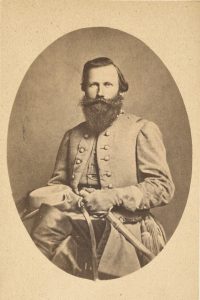On the March: Jeb Stuart ambushes a Maine regiment
Jeb Stuart could not resist ambushing Union infantry marching through northern Virginia on Thursday, June 25, 1863. The particular Yankees he attacked belonged to the 19th Maine Infantry Regiment (Col. Francis E. Heath), until that moment unbloodied in combat.

Assigned to the 1st Brigade (Brig. Gen. William Harrow), 2nd Division (Brig. Gen. John Gibbon), II Corps (commanded since June 10 by Maj. Gen. Winfield Scott Hancock), the 19th Maine “broke camp” on Sunday evening, June 14 and marched out “about two miles and then marched back … again,” said Pvt. John Day Smith. A farmer from Litchfield in Androscoggin County, he served in Co. F.
The Mainers marched some 20 miles Monday in “intense heat and clouds of dust,” reached Wolf Run Shoals on the Occoquan River on Tuesday, and Sangster’s Station on the Orange & Alexandria Railroad on Friday, June 17. En route Smith watched weary comrades “throw away a nice overcoat, a nice woolen blanket or a change of underclothing” to lighten their loads.1
Camping at Centerville on Friday, June 19, the 19th Mainers promptly got into trouble by “joining in a raid on a sutler belonging to one of the Massachusetts batteries,” Smith explained. Only a month back in uniform from Confederate captivity and lacking an official job with the Army of the Potomac, Brig. Gen. William Hays “ordered two guns and a small force of infantry into position to disperse the mob.”
Before the artillery-toting provost guard arrived, “not only the ‘mob’ but the contents of the sutler’s tent had been ‘dispersed,’” particularly the tobacco stuffed into men’s haversacks and other hiding places, Smith reported.
Onward II Corps tramped. “The march took us across the old Bull Run battlefield,” Smith said. “Parts of human skeletons were seen protruding from the ground and splintered trees were upon every side.”
After resting four days near Thoroughfare Gap. II Corps headed out on June 25, with Gibbon’s division bringing up the rear. The 19th Mainers marched through Haymarket in Prince William County. No one paid attention to “a lofty eminence to the right and rear,” Smith remembered.
At 1 a.m., June 25, Confederate cavalry brigades had “with noiseless march moved out” from a camp “near Salem Depot,” Maj. Gen. Jeb Stuart reported. “As we neared Hay Market, we found that Hancock’s corps was en route through Hay Market for Gum Springs, his infantry well distributed through his trains.”
Stuart was trying to pass east to ride around the moving Union army, and Hancock, Heath, and the 19th Maine were in the way. As he had at Harrison Landing the previous July, Stuart introduced himself to his enemies rather than wait quietly to gain a better advantage.
“I chose a good position” on the hill noticed by Smith “and opened with artillery on his passing column with effect, scattering men, wagons, and horses in wild confusion,” Stuart said. His well-handled horse artillery “disabled one of the enemy’s caissons, which he abandoned, and compelled him to advance in order of battle to compel us to desist.”
From that “lofty eminence … came bursting shells into the midst of our Brigade and we lost one man in our Regiment, Israel D. Jones, of Company G, the first soldier in the Regiment killed by the enemy,” said Smith.
A Westport farmer, Jones was 21 and married when he enlisted in early August ’62. Standing 5-6½, he was viewing Virginia through his blue eyes when the shell exploded. Death was instantaneous.
“In less than ten minutes from the time that Mr. Jones was chatting cheerfully with the man marching at his side, he was buried by the roadside and left to sleep his last sleep,” Smith said.
The 19th Mainers tramped north through Virginia, crossed the Potomac River on a pontoon bridge, and camped June 28 at Monocacy Junction. Now commanding the army. Maj. Gen. George G, Meade wanted II Corps to “set out early in the morning” of June 29 “and proceed to Uniontown” in Maryland, but an orderly evidently took a wrong turn, because Hancock did not receive his marching orders “until between eight and nine o’clock in the morning,” Smith recalled.
The 2nd Division led II Corps on this “hot, sultry morning,” he said. The miles fell away across Maryland — and suddenly the 19th Mane passed “through one of the most beautiful and fertile regions of the whole country … a long, beautiful valley, shut in on both sides by hills and settled by prosperous farmers,” Smith observed.
“It seemed like paradise to the soldiers who had for so long tramped over the desolate and barren soil of Viginia,” he commented. “Cherry trees, loaded with rich cherries, were upon the roadsides.”
Civilians turned out to welcome their blue-clad saviors. “The hospitable people brought bread and milk to the tired and hungry soldiers,” Smith said. He claimed “there was no time for eating or drinking,” but surely the Maine veterans accepted bread loaves thrust at them and, whenever possible, gurgled down milk cold from the spring house.
“The column pressed forward” without stopping, Smith insisted. Men grumbled in the ranks — soldiers always do — but they “knew that some emergency had arisen which required and painful march.”
Gettysburg lay over the horizon.2
1 John Day Smith, The History of the Nineteenth Regiment of Maine Volunteer Infantry 1862-1865 (Minneapolis, 1900, 55-56; Joseph W. Kirkley, Itinerary of the Army of the Potomac and co-operating forces, June 5-July 31, 1863, War of the Rebellion: A Compilation of the Official Records of the Union and Confederate Armies, 27 (1), 142; John Day Smith Soldier’s File, Maine State Archives
2 Smith, History, pp. 62-64; James Ewell Brown, OR, 27 (2), 692-693; Israel D. Jones Soldier’s File, MSA